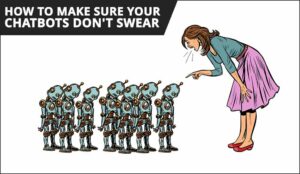Kay Phelps of 8×8 discusses the thoughts of numerous industry experts on key “bot topics”, including transparency.
How Transparent Should You Be About Chatbots?
When offering customer assistance via a chatbot, do you let customers know they’re not talking to an agent? Or do you try to make it seem like they’re chatting with an agent?
“Tell them right out of the gate. If you mask a chatbot as a human, I think I’m talking to a dumb human,” said one contributor during Customer Contact Week’s interactive discussion groups, focused on managing the transition between self-service and assisted-service.
Lively discussions ensued, centred primarily around chatbots.
Participants included representatives from:
- New York Life
- Macy’s
- Fiserv
- CORT
- Lithium Technologies
- InfoCision Management
- Pacific Gas & Electric
- and many more major companies.
Some felt it is unnecessary to point out that the customer is not connected to an agent. One participant said: “Don’t hide, but don’t advertise.” Others felt that trying to pass a chatbot off as an agent was a recipe for poor customer experience.
Several experts recommended starting simply. Chris Wissmann, a business analyst at CORT, advised: “Take care not to overthink your initial implementation of a chatbot. Start simple, and stay in a constant loop of feedback and improvement.”
“If you try to tackle something more complex out of the gate, you risk frustrating your customers by not giving them the help or support they need in a timely manner.”
“Also, be upfront about the fact that the customer is talking to a bot—otherwise you could be damaging trust with your customer.”
Setting Up and Maintaining Chatbots
One point of agreement is that chatbots are time consuming to set up and maintain. As one attendee said: “How much you put into it is how much you’ll get out of it.”
He stressed that daily work is needed to keep the chatbot current, adding: “A chatbot is only as good as the data it has.”
Another felt that chatbots are “glorified FAQs” and can lead to confusion if the system cannot clearly understand the “ask”, citing an example of being stuck in an endless loop and a poor customer experience.
“If it’s not done well, customers remember the hassle,” one participant said—and that can damage the brand.
Participants agreed the type of business you are in and the type of requests you get will dictate whether self-service will work or not.
For example, when weather disrupts major events, such as a rainout at a ballgame, “customers just want their answers,” says the Global Director of Customer Operations at the world’s largest ticket marketplace: “We look at it (self-service) as getting an answer to customers in a better way.”
Getting customers a yes/no answer about whether or not the game is cancelled is the type of request chatbots are perfect for.
On the other hand, a representative from Baxter Medical pointed out that in his industry, customers need immediate answers about complex medical devices and pharmaceuticals—and handling those requests by chatbot would be close to impossible.
Be Strategic
“Business leaders must not only create a strategy but also see it through,” said Samantha Poole, Client Solutions Director at InfoCision Management.
When does it make sense to offer a chatbot? A Director of Business Technology from Voya Financial advised: “Be strategic about it. What are volume drivers?”
Analyse the customer journey—see what web pages the customer has visited so you will know if he or she is struggling and deduce the reason for the struggle. Then proactively offer help.
When you personalise assistance with knowledge about the customer, you can “seem boutique without being boutique”, said Rhiannon Leitterman, Director of Participant Services at Empower Retirement.
Another participant advised to be sure to measure the deflection rate when implementing chatbots and other self-service tools.
Her company put a chatbot into FB Messenger and she said: “Customers love it. We reduced calls by more than half.”
But, after celebrating deflection from agents to self-service, they learned “what’s left is the harder stuff”.
With agents now getting more complex enquiries, average handle time rose and satisfaction among customers who interacted with the contact centre went down.
She advised other companies to set expectations accordingly and to assess correlation and causation.
Is Your Business Using Chatbots?
Are most businesses already using chatbots? Not yet. Victor Verastegui, VP of Operations at New York Life, emphasised that it’s important to consider how tech-savvy your customer base is.
“Don’t invest in technology customers haven’t caught up to yet,” Verastegui advised.
An attendee from Baxter Medical raised another important point. While many of the requests his company gets are far too complex and high-stakes for a chatbot, there are certainly some “low-hanging fruit” types of enquiries that could be handled by a self-service system.
Will Chatbots Replace Agents?
With the growing use of chatbots and other forms of self-service, will agents become a thing of the past?
Not a chance. Without exception, all agreed that in the foreseeable future, complex issues will still require an agent’s attention.
In the meantime, how do you sell your executives on the need for new technology that will serve to reduce agents’ workload?
“Don’t use contact centre terms,” advised a Customer Operations Director from the ticket marketplace.
“Don’t talk about handle time and first contact resolution. Talk about productivity and throughput, and customer experience. The CEO doesn’t need to know contact centre metrics.”
Final Takeaway: Know Your Audience
The final takeaway from the three discussion groups is that the key to transitioning between self-service and assisted-service is to ensure that context is maintained throughout the interaction.
When evaluating whether self-service is appropriate, companies should consider their customers’ needs and the types of requests they typically receive in the contact centre.
Trying to address all issues with self-service is rarely a good idea. Companies can instead focus on implementing chatbots or other self-service options in targeted areas where it will improve customer service.
Author: Robyn Coppell
Published On: 24th May 2019 - Last modified: 28th May 2019
Read more about - Guest Blogs, 8x8
















